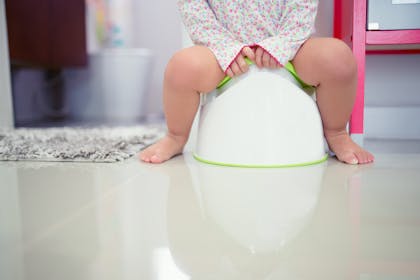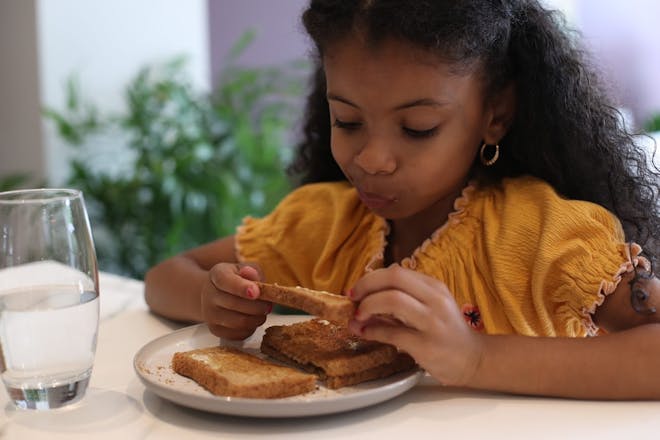The 10 symptoms you should never ignore
Kids are always picking up bugs and getting high temperatures, it's par for the course. Sometimes though, it's difficult to tell whether your child's condition is serious enough to visit A&E. Here are 10 symptoms to look out for, which should always be checked out by a doctor.
Knowing when to call your GP for an emergency appointment, or making the decision to take your child to A&E is never an easy call. We don't want to be that paranoid parent, or labelled a time-waster.
With this in mind, we've compiled 10 symptoms all parents need to take note of.
Remember, this is only a guide. You know your own child and you should always see your GP if you're worried.
1. A swollen face

Has your child’s face swollen? Is their tongue swollen? Is their skin itchy? Are they finding it hard to breathe?
This could be anaphylaxis, an allergic reaction, which can be caused by things such as insect bites or food like peanuts.
This is a medical emergency and requires immediate treatment. Call 999 or head to your nearest A&E as soon as possible.
Some children with a previous history of anaphylaxis will have an auto-injector of adrenaline (e.g. an EpiPen), so this needs to be given immediately, but you must still seek emergency help.
Find out more about anaphylaxis here.
2. A very high temperature

Coughs and colds are rife in kids and it's comon for them to have a fever – a temperature that rises above 37.5°C (99.5°F).
Other illnesses, such as flu and ear infections can also cause fever.
In most cases, a little bit of TLC and home treatment, e.g. with children's paracetamol or ibuprofen.
If your child is distressed before the next dose of paracetamol OR ibuprofen is due, you may want to give the other medicine later. Note that paracetamol can be given in four-hourly doses, with a maximum of four doses in 24 hours. While ibuprofen is given in six-hourly doses, with a maximum of three doses in 24 hours.
The NHS gives this example:
8am: paracetamol dose given
11am: child remains distressed, ibuprofen dose given
2pm: child remains distressed, paracetamol dose given at the same time, but if one doesn't seem to work you can try the other later).
Try to get your little one to drink little and often to keep his fluid levels up – babies should be given plenty of liquids, such as breastmilk or formula. Sponging your child with cool water isn't advised.
You will need to get medical advice if your child is under three months old and has a temperature of 38°C (101°F) or above, or is between and three and six months old and has a temperature of 39°C (102°F) or more. Contact your GP, visit your local out of hours service, or call 111.
Also see your GP if your child has a fever and also other symptoms, such as persistent vomiting, refusal to feed, floppiness or drowsiness.
Ultimately, trust your gut instincts. If you feel your child is very unwell, seek help and advice straight away.
3. A long-lasting temperature

If you have treated your child’s fever with children's paracetamol or ibuprofen, and the temperature still remains high, contact your GP.
Your child’s body may be struggling to deal with the infection, and you’ll need to get a doctor to investigate further.
For most children, fevers clear up in a few days, if not, seek medical advice from your GP.
It’s a sign that the condition isn’t caused by a virus that can be fought off by your child’s immune system, but may have a bacterial cause, which requires antibiotic treatment.
Invest in a good quality thermometer, like this model by Braun that can be used in the ear or on the forehead. See more details, here at Amazon.
4. High temperature and a stiff neck/ headache

If your child has a fever and feels very unwell with a headache or stiff neck, this is a warning flag for meningitis, and you will need to seek urgent hospital medical care.
Other things to watch out for is if your child appears vacant and unresponsive, and is uncomfortable with bright lights.
There may also be a rash. This will look blotchy, often with small red dots. It’s different from other rashes, as it won’t fade when a glass is rolled over it. This does not always develop.
If you think your child – or anyone in your family - has meningitis, call 999 or head straight your nearest A&E.
5. When bleeding won't stop

Falling over is par for the course when you're a kid – a hug and a plaster usually makes things better.
But if your little one is bleeding a lot and you can’t stem it after 10 minutes of applying pressure, they'll need further medical attention, such as stitches.
Take them straight to A&E, or – if there's one near you – the Minor Injury Unit (MIUs) and urgent care centre (UCC). Check in advance it's able to treat young children, as not all do.
6. When a child vomits after a fall

When your little one tumbles over, it usually looks worse than it is.
For children over six months old, if it’s a short fall (less than their height), and they don’t land on any sharp objects, they'll probably be fine aside from a few tears and perhaps the embarrassment factor.
But if a fall is accompanied by vomiting, loss of consciousness, or your child seems confused or disorientated, you will need to head to A&E.
For babies still under six months old, it’s important they always get checked by a doctor after a fall.
7. Sudden stomach ache

Tummy aches can be pretty frequent in children, whether they’re real or imagined to get out of a day at school. But you can usually sniff out the 'fake' ones by the way your child suddenly wolfs down their breakfast!
You do need to take notice when your child complains of a stomach pain that develops on the lower right side – especially if becomes constant and severe.
This is because it may be appendicitis, a painful swelling of the appendix, which needs urgent medical attention.
If he has sudden cramps which come and go on either side, you also need to be alert, as appendicitis can start around the tummy button and move to the right.
They may lose their appetite, feel sick, and might have diarrhoea.
If you suspect appendicitis, contact your GP or call 111 immediately.
8. Breathing problems

If your child’s rib cage and stomach sucks in as they struggle to breathe, or there's a whistling sound when breathing, you need to seek medical help.
These symptoms may also be accompanied by blue-tinged lips. The problem may be croup or severe bronchiolitis (an infection with symptoms that usually start like a cold i.e. a runny nose and cough).
Signs of bronchiolitis in babies include poor feeding (your child has taken less than half their usual amount during the last two or three feeds), they've had no wet nappy for 12 hours or more, high temperature and a breathing rate of 50-60 breaths per minute.
There may be other underlying causes of poor breathing, such as allergy or asthma.
If your child is having breathing problems, you need to call 999, or get to A&E immediately.
9. If weeing stops

Sudddenly noticed fewer wet nappies? Toddler not going on the potty or child seems to be going to the loo less often?
This may be a warning sign of dehydration, which will need checking out with your GP.
Other signs to watch out for in babies include a flattened fontanelle and skin that’s dry and doesn’t ping back when gently pinched.
Dehydration may occur after vomiting or diarrhoea, so it's important to get your child drinking little and often in this case.
10. Changes in your child's moles

Although skin cancer is rarer in children than adults, it’s not unheard of, and it’s a good idea to keep an eye on moles.
Get into the habit of checking moles about once a month – those that your child has had since birth and new ones that may have appeared.
Moles that are irregularly shaped, or which appear ragged, raised, increase in size or aren’t uniform in colour should be checked out with your GP.
Find out more on how to check moles, here.
This article contains affiliate links, which means we may earn a small amount of money if a reader clicks through and makes a purchase. All our articles and reviews are written independently by the Netmums editorial team.





